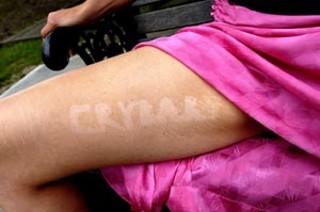Summer Fun
Can the tan: options for the pale and pasty
By Diana Welch, Fri., May 14, 2004

For many of us, the sun is an evil thing, poking its way through various holes in the ozone like a zombie through a screen door. We spend most of our time scurrying from one air-conditioned shelter to another, smearing thick white substances all over our sweaty skin and wearing ridiculous hats to avoid its ultraviolet death rays. One would think, from the way we behave, that the sight of golden tone on human skin would make us cringe in disgust. But, no. Even in this state filthy with sunlight, there are legions of tanning loyalists who demand to have continual access to the sun's effects, day or night. It doesn't even have to be a real tan from real sun; true tanning enthusiasts actually prefer the controlled environment of a salon.
So, armed with two unlucky volunteers willing to put their pale complexions to the test of the tan, the Chronicle decided to sniff around into the sizzling underworld of the indoor tanner, heading straight into the belly of the beast: a local tanning salon.
Upon arrival, we were greeted by a pretty 21-year-old tanning professional named ... well, we'll call her Amy. Immediately noting the pasty pallor of our volunteers, Amy sweetly assured them that she'd "seen worse," while sliding a couple of release forms across the counter for them to sign for the purpose of assuring the suits that we wouldn't sue if, say, someone melted or shriveled up. She then took us on a tour of the facilities, room after room of tanning beds with varying levels of bronzing power. Frightened by the eerie hum and whir emanating from behind closed doors, our less and less willing participants began edging ever closer to the door, ready to run screaming from the salon at any moment, with visions of burnt skin trailing behind them in chunks. Amy calmly assured us that the beds were indeed a comfortable experience.
"It's just so relaxing," she said, rather convincingly. "I think it releases endorphins in your body or something, because it makes you feel really, really good." And she should know, having worked at this particular salon since high school, when her first tan in preparation for a dance got her hooked on the bulb. She describes tanning as an almost meditative experience where the heavenly heat just melts away her troubles. And, according to Amy, using a tanning bed regularly is actually good for you, giving you vitamins you need to stay healthy. Healthy as a leathery old grandma, we wondered? "You need to come in like, once, twice, three times a week," she explained, "just so that later on in life you won't get bone disease because you're vitamin D deficient."
So, why wouldn't we just soak up the rays in the out of doors? To get some perspective, we looked to the grim reaper of the tanning world: the dermatologist. Dr. Bill Ramsdell, a frequent spokesperson for the American Cancer Society, cleared up the confusion, explaining that, in fact, the beds themselves produce not one molecule of vitamin D. For the most part, vitamin D is acquired from food. Any vitamin D acquired in the tanning process would come from the sun itself, not a magical bed of manufactured light.
"The tanning industry is remarkably aggressive in their marketing, saying it's safe," he sighed, exasperated. "Natural sunlight is made up of both UVA and UVB rays. B causes your skin to burn, while A penetrates deeper into your skin, damaging collagen and elastic fibers and causing the formation of free radicals, or carcinogenic molecules." So in essence, since tanning beds are almost exclusively UVA rays and won't physically burn your skin, tanners are lulled into a false sense of security, exposing themselves repeatedly to the damaging rays, cooking their flesh to the crisp golden brown of a juicy Thanksgiving turkey.
So, what's a person to do if she wants a fake tan like Amy but doesn't want all those free radicals swimming around beneath her skin? Spray it on! Why the hell not? Amy says that she'll spray when there's an event that she just has to be tan for, like say, her birthday or spring break. The spray is made up of dihydroxy acetone, a simple three-carbon sugar that magically and mystically stains whatever it touches. Even Dr. Ramsdell thinks spray-on tans are great, except for the fact that they only further the misconception that a tan is healthy. But Amy just looked so good. So, we made our volunteers don shower caps and duct tape (to make fabulous designs, of course!) and get into the booth. Amy was kind enough to give us all the safety training, where our first timers were told to get naked, push a red button, and jump into a plastic shower stall where their new healthy glow would blast from nine strategically placed nozzles. Most importantly, they were to hold their breath, close their eyes, and march around in a teeny circle, swinging their arms high to ensure even coverage.
Unfortunately, despite Amy's explicit instructions, one sprayee began to yelp and flail about when the nine nozzles were loosed upon him, causing the dihydroxy acetone to shoot straight into his mouth.
"I panicked and forgot all the rules," he sputtered miserably, "and now my throat burns really bad." Well, maybe he's on to something. Maybe the browned-lung phenomenon seen only before in smoking enthusiasts will become chic in the seasons to come. Who knows?![]()








